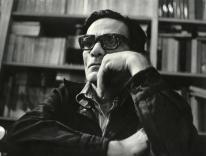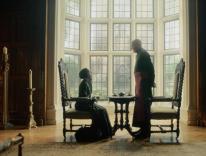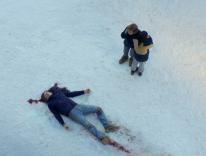While watching The Diving Bell and the Butterfly it came home to me more clearly than ever that literature strains to do what cinema achieves easily: capture the sheer, palpable physicality of the world. Literature’s real victories are won precisely where film huffs and puffs: the inner world of thought.
Jean-Dominique Bauby’s memoir is one of the most soul-stirring books ever written. A stroke left the forty-three-year-old editor of the French fashion magazine Elle a prisoner within his own body, a victim of locked-in syndrome, completely unable to move or talk, though his vision, hearing, and thinking remained. To allow him to communicate, his therapist employed a system in which she recited the alphabet until Bauby blinked his selection of a letter, with two blinks signaling the end of a sentence. Thus, he dictated The Diving Bell and the Butterfly, a tour of his condition, a record of his thoughts, a tribute to his loved ones and caregivers, a scrapbook of his past, and—if any book has ever deserved the encomium—a tribute to the human spirit. The butterfly of Bauby’s spirit refused to be trapped by the diving bell of his body.
The first half-hour of Julian Schnabel’s 110-minute adaptation is powerful and unique, even more so than the opening pages of the memoir, for it sets before us Bauby’s desperate physical condition with a directness no work of literature could match. As the stroke victim’s mind floats up into consciousness, we perceive his new surroundings strictly from the point of view of a paralyzed person strapped to a bed, the doctors and nurses hovering over him, swooping down to his face to speak, everyone moving into and out of his sightlines. The first minute or so is a blur since his sight hasn’t adjusted, but even when it sharpens, the camera renders everything the fashion editor sees as weird and discombobulating, as if Bauby were a fish in an aquarium gawked at by the medics. Schnabel (who made his name as a painter) and cinematographer Janusz Kaminski (who shot Schindler’s List and Saving Private Ryan) never let this odd perspective deteriorate into a technical stunt but render it as a sort of horrific rebirth. The lowering, peering, interrogating faces are clearly on a mission of rescue, yet are unavoidably resented by the macho, hedonistic editor. And while we are watching all this, Bauby’s unheard (except by us) commentary, remonstrating with his fate and ridiculing the assumptions of his caregivers—Doctor: “Thus, medical science allows us to prolong your life.” Bauby (to himself): “This is life?”—is by turns touching in its desperation and hilarious in its sarcasm. (Ronald Harwood’s dialogue is always apt.)
Schnabel captures oddities the way the horrified Bauby must have noticed them from the pit of his illness: the stubble on a doctor’s cheek; the same doctor’s attentive manner, as he stands just behind the head physician’s shoulder, registering both agreement and scientific fascination with his superior’s diagnosis; the way Celine, Bauby’s longtime lover and mother of his children, ducks down below his (and our) sightline as she kisses his hand.
Once we adjust to this visual novelty, the movie becomes even more poignant as the therapy proceeds. The therapist, Henriette (played memorably by Marie-Josée Croze), is almost evangelistic in her determination to keep her patient in touch with life. When he tells her he would rather be dead, she calls his wish “disgraceful” and “obscene.” As played, this doesn’t come across as self-righteousness. Henriette rushes from the room in tears but, knowing she hasn’t behaved professionally, returns and apologizes. So moving is she in her thwarted fervor that Bauby himself wants to apologize. Nowhere does his entrapment communicate itself so powerfully as at this moment when he can’t fully respond to this beautiful, saintly young woman. Has a scolding in a movie or play ever been as moving as this?
Inevitably, a quarter of the way into the movie, the director abandons the strictly first-person point of view and Bauby moves into camera range in the person of actor Mathieu Amalric. We don’t feel this transition as a letdown into conventionality as long as what’s presented remains true and fresh. And a good deal of it is thanks to the performances of Amalric (who looks like a young Roman Polanski and has the same air of libidinous mischief), the heart-melting Croze, the equally moving Emmanuelle Seigner as the faithful ex-mistress trying to reach Bauby’s internal world with the alphabet-blink system, and Max von Sydow, as formidable in French as in Swedish or English, as Bauby’s crotchety, loving father.
But there is some slippage into triviality when the film delves into Bauby’s memories and fantasies, a serious fault since that mental traveling constituted the invalid’s victory over his condition, quite literally mind over matter. Schnabel often fails to wrest the full significance of certain events and imaginings that in Bauby’s narrative are captivating. For instance, a visit to Lourdes that the editor took with a former girlfriend was a masterpiece of limpid irony on the page but on the screen comes across as only a bit weird. Also merely odd is Bauby’s fantasy about the ghostly visitations of the nineteenth-century Empress Eugenie, benefactress of the Calais hospital treating Bauby. In the book she is simply and charmingly presented as Bauby’s confidant, but her film scenes come across as failed Fellini.
Both book and movie climax with Bauby finally recalling the stroke itself, suffered while he was driving his son to a play. Watching the movie, I couldn’t understand why the beginning of the hero’s condition should be used as the capstone of the story. But in the book the scene merits its place because the very fact that Bauby can recall the awful event at all is a climactic triumph of his recovering mind, and that he can write about it so well and so unhysterically is a tribute to creativity operating in extremis.
This exceptional movie both benefits and suffers from the unique nature of film, so vivid in its depiction of the physical, so challenged in its rendering of thought.
Please email comments to [email protected] and join the conversation on our Facebook page.
Share
Previous Story
Slow the Presses
Next Story
Taking Stock


